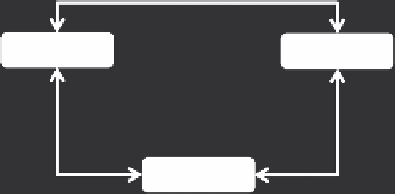Geoscience Reference
In-Depth Information
Discover
Produce
Publish
FIGURE 10.1
Fundamental components of the e-Research process.
name implies, the virtual organisation comprises a set of activities which can be linked together in
a distributed way with some underlying corporate purpose, which could be to generate commercial
value or deliver effective planning, most likely to pursue a research project or programme in an
academic context. It is not coincidental that AstroGrid characterises itself as a
virtual observatory
or the myGrid BioInformatics product suite as a
virtual laboratory
.
It is largely for this reason that in the remainder of the chapter, we will prefer the more flexible
term e-Research to grid computing (or indeed alternatives such as the
cloud
which we will come
to later). Through analogy with e-Business, the term e-Research is intended to convey the idea of
emergent information environments in which virtual projects and research collaborations are dis-
tributed flexibly in (hyper-)space.
Some fundamental components of the e-Research process are shown in Figure 10.1. The process
of discovery through research is shown as a cycle, in which the most natural starting point is prob-
ably
resource discovery
at the top left of the figure. In this phase of the cycle, existing literature and
experimental results might be sifted and evaluated and the goals and objectives of a new investiga-
tion specified. This process would also include the identification and evaluation of existing data
resources. Moving into the next phase of
resource production
, new computational experiments
are created, executed and enhanced for the purpose of the investigation. Once these are judged to
be successful, or at least novel and interesting, then the results can be (electronically)
published
.
If managed correctly, these results can then be
discovered
and form the inputs to new scientific
investigations.
The chain of activities shown in Figure 10.1 is frequently referred to as a model of the
research
life cycle
(e.g. Microsoft Research, 2009) and is clearly similar to conventional approaches to
research in the social and natural sciences (including both human and physical geography and the
environmental sciences), for example, in the design of social surveys, or in laboratory investigations
of soil cores or hydrological samples. However, a number of features of this model probably bear
further emphasis. It presents a strikingly open view of research. The focus on publication is enor-
mously strong. Ardent supporters of e-Research would probably argue that the power of the virtual
organisation lies even more in its ability to bring together whole networks of scholarly endeav-
our (sometimes referred to as
communities of practice
) than simply the sharing of computational
resources. Note that the publication stage of the e-Research life cycle provides the context in which
procedures can be annotated, documented and ultimately reproduced. As Brunsdon (2014) argues
convincingly elsewhere in this topic, the reproducibility of computational experiments is crucial if
they are to be shared freely and effectively.
Semantic integration of resources is also crucial, as effective categorisation provides the under-
pinning for resource discovery which must become increasingly effective as knowledge proliferates.
This view of the research life cycle does not overly concern itself with data generation. One can
presume that new observational evidence is introduced into the cycle at an appropriate point, but in
general, secondary data are important here, and one gets the idea that data themselves beget data
and that applications could quite legitimately build on sources of information which have them-
selves already been refined through several phases of computational experiments.

